If you need to wear a face mask or respirator for safety during COVID-19, now is not the time for a beard.
More: Beginner’s guide to the best respirators and gas masks
A French cut, fu Manchu, Dali, or extended goatee is also out of the question, according to the CDC. That’s because facial hair can interfere with the seal of tight-fitting gas masks and N95 respirators. With some sadness, I’ve traded my bushy beard in for a CDC-approved mustache. And I’m here to review the shaving methods I tried so you and your loved ones can also get your faces in gear.

The CDC’s recommendation isn’t a huge surprise — militaries have by and large banned facial hair for the same reason since World War I, the first major conflict that involved chemical warfare and gas masks.
So if you or someone in your household is likely to sport some facial fuzz, consider it a necessary part of your respiratory preparation to keep shaving supplies on hand.
More: Emergency kit checklist
And since we recommend having a respirator in your go-bags, it wouldn’t be silly to keep a razor in your bag, too. Particularly in kits you keep stored away from home. Consider, for example, if a major chemical spill happens when you’re at work and you suddenly need to shave in a hurry with only the things you have nearby.
Here’s what you need to know:
- Facial hair interferes with the seal of tight-fitting protective masks like gas masks and N95 respirators
- If you insist on keeping your beard, it shouldn’t interfere too much with looser-fitting masks like bandanas, though it limits your options
- Another option to keep the beard is to slather it in petroleum jelly before strapping on your mask, but this is a problematic solution
- Straight razors seem like a logical choice, but have a number of drawbacks
- Safety razors are a great prep because of their durability and the fact that the blades are small and cheap, making them easy to stockpile
- Other accoutrements to so-called wet shaving, like shave soap and alum bars, are great preps because of their long life
- Consider keeping disposable or cartridge razors in your go-bag, because they’re lighter and more forgiving than a safety razor
Is vaseline a realistic option?
One trick circulated in prepper circles is to smear your beard in petroleum jelly to get a tight seal. YouTuber TEOTWAWKI Man demonstrates the technique in a video.
It’s a good trick to know if you can’t shave for some reason, but shaving is still a better choice because:
- Petroleum jelly also breaks down rubber and other polymers, so it could damage your mask over time.
- You need to keep a tub of petroleum jelly alongside your mask or respirator.
- Having to smear your face in jelly slows you down when you need to don a mask quickly, like if a potentially infected visitor is at the door or if there’s a gas attack of some sort.
- Your hands will then be smeared in grease, which could cause all sorts of problems in an emergency.
- Your face will then be covered in grease, which is unpleasant at best.
Getting rid of the beard: use electric clippers
Unless you have a perfectly honed straight razor and the skill to wield it, the easiest way to get a beard off your face is to use electric clippers. My preferred brand is Wahl. I’ve been using their hair clippers and beard trimmers to groom my head for years.
This Wahl battery-powered stainless steel beard trimmer is highly regarded, but if you’re just getting rid of your facial hair and not trimming it, hair clippers will suffice (if you can find them in stock), and as a bonus, you can cut your own hair!
Wahl makes cheaper plastic clippers, which I don’t recommend. I purchased a complete hair cutting set about a decade ago with a chrome hair trimmer and chrome beard trimmer and they’re still going strong. You want to get a set with all the various hair guards. They’re expensive if purchased individually and the complete kit will give you flexibility.
Once you’ve buzzed the beard down to stubble, you’ll need a finer tool to get your face smooth and ensure a good seal. The Internet is chock full of shaving opinion and advice, but I’m going to look at all of these methods through the lens of preparedness.
Things to consider when buying shaving preps
- Are there any disposable elements? If so, how hard are they to source or stockpile?
- Could the method cause injury or enough irritation to force you to seek medical attention?
- How light and compact can you make your shaving kit?
- How much maintenance does your shaving setup require?
With these criteria in mind, let’s look at each shaving method to see how they stack up.
Cartridges and disposables
The most popular shaving method are the ubiquitous plastic cartridges and disposable razors, especially of the three-bladed variety like Gillette’s Mach 3. If you have ever shaved, you’re probably familiar with these, so they don’t require much explanation. Let’s take a look at the pros and cons of them as a preparedness item:
Pros of cartridges and disposables:
- They provide a clean shave with little chance of serious injury or irritation.
- They are lightweight, especially the disposables, which is a key factor for your bug out bag.
- No maintenance required. They’re basically idiot proof.
- Since they usually feature a lubricating strip, they’re more forgiving if shaving in the field without oils or soap.
Cons of cartridges and disposables:
- They’re expensive. Some cost as much as hundreds of dollars per year.
- Cartridge heads are bulky.
While serious shaving enthusiasts knock cartridges and disposables, in my tests even a cheap three-bladed Bic gave a great shave. I suspect that much of the hype behind wet shaving methods is due to the other accompaniments like shaving brushes, soaps, and oils, but more on that below.
However, in the event of a supply chain collapse, cartridges and disposables pose a serious problem. Like I said, they’re expensive and bulky, so they’re hard to stockpile. And even in the best of times, it’s an expensive way to stay smooth.
The electric razor
In the course of my research, I decided to look at how servicemen shave, since they have to maintain a high-quality shave, often in adverse conditions. Electric shavers were mentioned frequently in forum and Reddit posts, especially the lauded Braun Series 7, and cheaper portable razors like the Braun M60b.
Pros of electric razors:
- Can be used anywhere, even without a mirror.
- Almost no chance of cutting yourself.
- Don’t require creams or aftershaves, at least in theory.
- Are quick, at least in theory.
Cons of electric razors:
- They require power.
- You’ll be hard-pressed to get as smooth a shave as a razor will give.
- Higher-end models require annual foil replacements and sometimes special oil cartridges.
- They’re complex, which causes potential reliability issues.
- They’re noisy, which is bad if you find yourself in a situation that requires stealth.
- In my experience, they take as long and cause as much irritation as blades.
If you’re an electric shaver person, there’s nothing wrong with having one, but I would not want to be entirely reliant on it in case of an extended power outage. I recommend having a solid backup plan at home. However, you might consider one of the cheaper electric shavers for your bug out bag. They usually take AA batteries so they’re easy to power on the go.
The straight razor
Now we’re talking! Good, old-fashioned steel. In theory, a straight razor is the perfect shave prep because there are no disposable blades. As a blacksmith and blade guy, I want to love the straight razor, but it has a number of drawbacks as a prep.
Pros of straight razors:
- It will last forever if you know how to care for it.
- If you have the skill to wield it, it can give a perfect shave.
- It’s an extra blade to have on hand.
Cons of straight razors:
- Good straight razors aren’t cheap, and cheap straight razors aren’t good.
- Even if a straight razor isn’t suited to shave smoothly, it’ll be sharp enough to slice your face or fingers open.
- Straight razors require serious skill to use and maintain. Many straight razor shavers send their blades off for professional honing.
- The edge is incredibly delicate, so if you used it in an emergency to say, cut rope, it would likely take hours of honing to get it shave ready again.
- It’s by far the most time-consuming shave method.
When the pandemic first started, the only razor I knew I had was a cheap Red Deer straight razor from Pakistan that I picked up at a flea market. I honed and stropped it as best as I could and got what I thought were decent shaves. After I tried a disposable razor and a safety razor, however, I realized how poor of a job it had been doing.
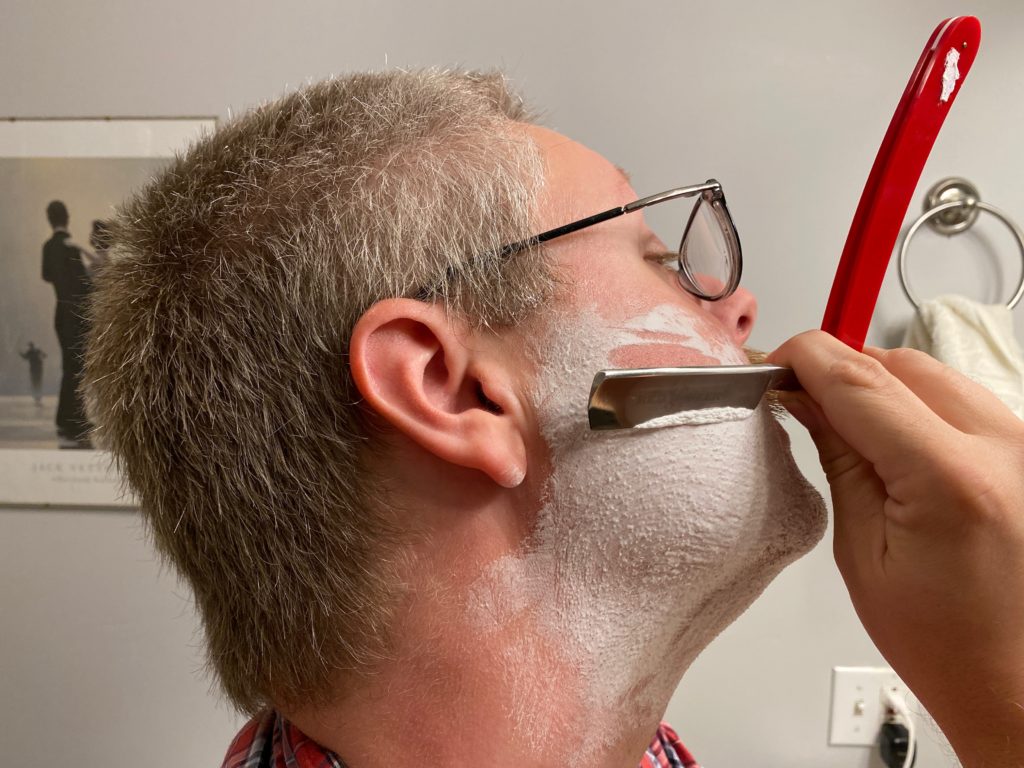
I understand that the Gold Dollar straight razor is a little better, but not by much. You can spend hundreds of dollars on a good straight razor. Granted, in the long run it might be the cheapest option, assuming you can maintain the blade yourself. Even if you’re an ace at sharpening knives, making a razor truly shave ready takes much more skill.
The other problem is that straight razors are inherently risky. I cut my face pretty badly several times. Not so bad as to resemble a German aristocrat, but bad enough. Once, my finger slipped when cleaning the blade and I sliced my thumb wide open. Thankfully a couple of applications of super glue saved me from a trip to the emergency room, but things could have been worse.
You might think I’m just a klutz and you’d do better, but there are three truths about shaving:
- We often shave early in the morning before we’re good and awake.
- Our fingers are slippery from soaps, creams, oils, or whatever we shave with.
- We’re often in a hurry.
If you shave with a straight razor, more power to you, but I don’t recommend it as a prep primarily because of the unnecessary risk.
There’s also a subcategory of straight razor called a shavette, which is a straight razor handle that accepts disposable blades. These are popular with barbers because they cut down on hygiene issues and maintenance, but for the average person I think they’re pointless. They combine the disadvantages of a straight razor with the disadvantages of a safety razor.
The safety razor
The safety razor came into fashion about the same time militaries required men to shave. Unlike a straight razor, they didn’t take considerable skill to master, but they do have a learning curve. Here’s a handy video that teaches the basics of shaving with a safety razor. They’re less wasteful than disposable razors and cartridges, because you have a steel handle that accepts small disposable blades without the plastic of a cartridge. Each blade lasts about a week and costs as little as 7 cents.
In case you can’t tell, the safety razor is what I recommend, at least for your home prep, but I want to dispel some of the mythology behind them. The Internet is full of articles touting safety razors as a miracle cure for a variety of shaving ailments. I won’t say those are false because everyone’s skin is different. But in my experience, it was no better in terms of irritation and bumps than a disposable or cartridge.
Again, I think most of the hype around the safety razor has more to do with the skin preparation that usually accompanies them, but we’ll get to that.
Pros of safety razors:
- It’s cheap! Beginner kits can be had for well under $50 and replacement blades cost mere pennies.
- Razor blades are not only cheap, but tiny. You could easily stack up 25 razor blades in the same space as five cartridges.
- Less risk of cuts than a straight razor.
- Loose razor blades can be handy as a prep.
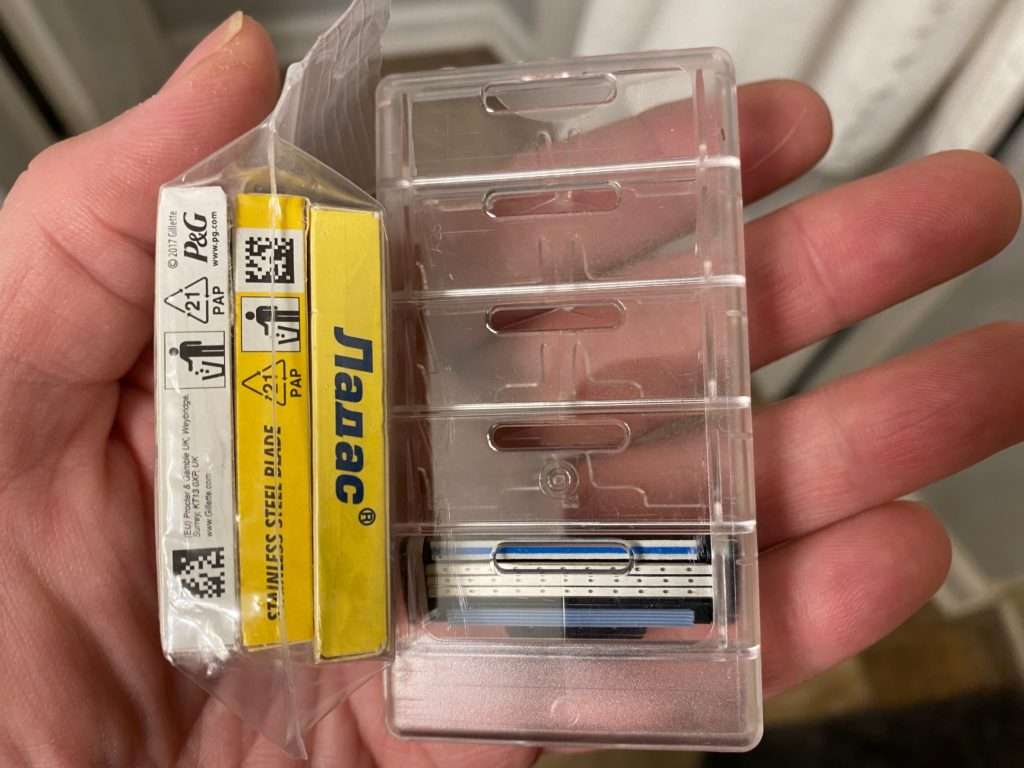
Cons of safety razors:
- It takes some skill to learn, though not nearly as much as a straight razor.
- Handling loose blades can be risky, but again, not as dangerous as using a straight razor.
- You have to figure out how to dispose of the razors.
- It can be incredibly unforgiving if you don’t prepare your face properly.
- The razor handles are fairly hefty, which is a problem in a go-bag.
All that said, I’ve found that a safety razor gives me a quick, reasonably close shave. If I shave with the grain, there’s almost no irritation at all. On the other hand, shaving against the grain is almost out of the question—it’ll tear hair out of your face and make you bleed like crazy. But shaving across the grain usually produces results as good as shaving against with a cartridge. I like to do a second pass across the grain on both sides of my mouth to ensure a tight respirator seal without much additional irritation.
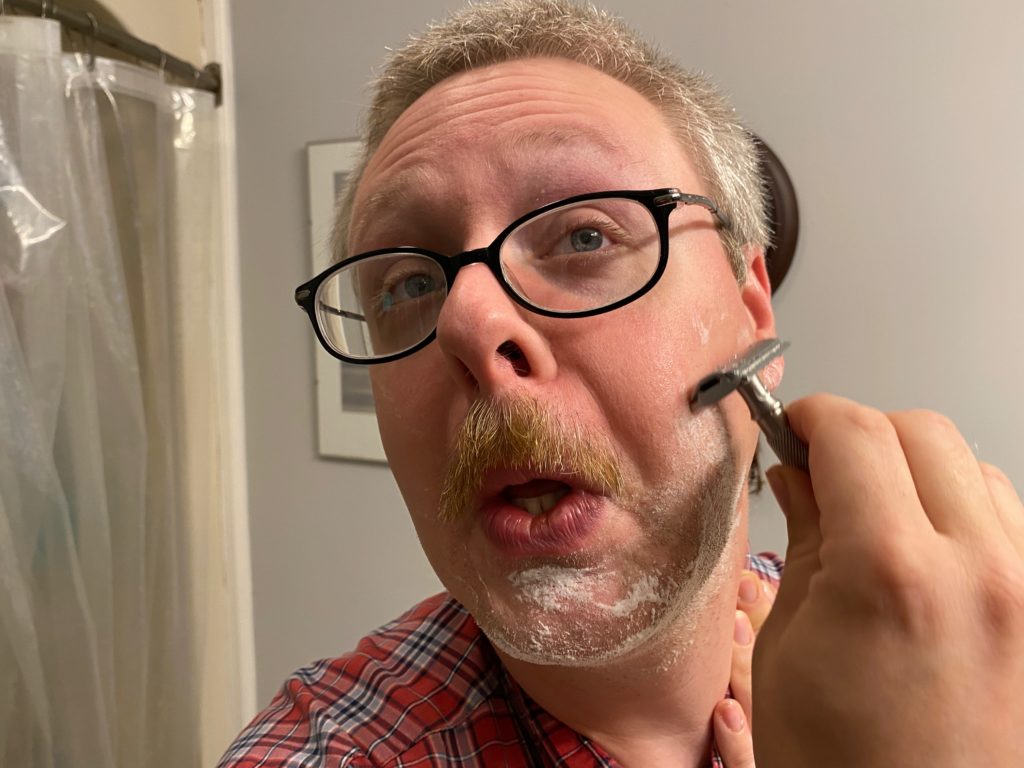
If you need a place to start, I decided on the Maggard Razors starter kit with the short handle, average beard head, and London Barbeshop shave soap. I’d also recommend adding an alum block to your order. The whole kit should cost you less than $50 after shipping and will keep you shaving for at least 15 weeks. I also recommend a blade bank to safely dispose of used razors.
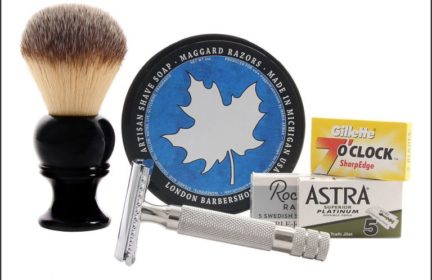
Safest shave and best result
Maggard Razors Basic Kit
After giving it a go and seeing if it works for you, you can stockpile razor blades. I ordered 200 of these Astra blades for a bit over $12. That’s 200 weeks of shaving!
You might not feel as cool or gutsy as the straight razor crew, but if a safety razor was good enough for Sean Connery’s James Bond, it’s good enough for you.
Shave brushes, soaps, and other gear
Straight razors and safety razors fall into the world known as “wet shaving.” Since these old-fashioned blades don’t have fancy lubricant strips or angle guides, it’s on you to properly prepare your face and use the proper technique. That means lathering up old-fashioned shaving soap with a brush, and maybe putting on a shave oil before you soap up your face.
Oil and shave soap make a big difference if your skin is sensitive, and I think they deserve most of the credit usually attributed to the razor. One of the best shaves I’ve ever had is when I put a little oil on my face, lathered up with shave soap, and shaved with an old disposable Bic razor.
I don’t have recommendations for oil, but I don’t think you need anything fancy. I put on some old olive-based beard oil I had sitting around and it works fine. You could even use coconut oil or lard. Proper oiling doesn’t take much.
A lot of guys are turned off by the idea of using shave soap, but I’ll forever be a convert. Shaving soap gives a much better lather than foam or gel, and it’s less wasteful. Don’t you hate it when you’re out of shaving cream propellant but you can still hear cream sloshing around in there? A puck of soap can last months, and a lot of guys throw scraps from the shower in a bowl to get every last bit out of them.
The most important thing when it comes to shave soap is a soap brush. They might seem silly, but they’re incredibly useful. Here’s why. Soap + razor blade = bad news.
The Maggard kit I recommend includes a synthetic brush. You can get fancy brushes made from a variety of animals, but the synthetic came highly recommended and I like how it feels on my face.
Lathering with a brush isn’t especially hard or time consuming. You’ll want a tin or bowl of soap and a small bowl or mug to lather with:
- Soak the brush in a bowl of lukewarm water while you shower
- Dump out the water and flick the water out of the brush
- Swirl the brush around the soap to load it
- Vigorously swirl the brush in your bowl or mug to lather the soap
The whole process might just take a minute or two more than squirting goop out of a can. And I think the results, lower cost, and, most importantly, lower reliance on the supply chain, make it well worth it.
Finally, the aftershave. While I enjoy my fancy Nivea aftershave lotion, you might also want to keep an old-fashioned alum bar around. It stings like hell and tightens up your face, but it does a great job at keeping irritation and rashes at bay, and a bar lasts a very long time. As a bonus, it’s also an effective deodorant.
Shave recommendations
While I recommend trying a safety razor as part of your general prep, shaving is a highly individual thing. If you have a method that works for you and you can source the needed consumables, don’t feel pressured into switching, but do consider having a safety razor at least as a backup.
As for your go-bag, a safety razor is a fine addition, but it has a few drawbacks: a somewhat heavy handle, the potential hazard of loose razors in your bag, and the preparation needed for proper use. You likely don’t want to haul a shave brush in your go-bag, so I’d recommend a cheap and lightweight disposable of your choice, which should last you a couple of weeks. A disposable combined with camp soap and a signal mirror should make for a passable field shave. If you have the space and don’t mind keeping up with batteries, you might consider one of the aforementioned electric shavers as well.
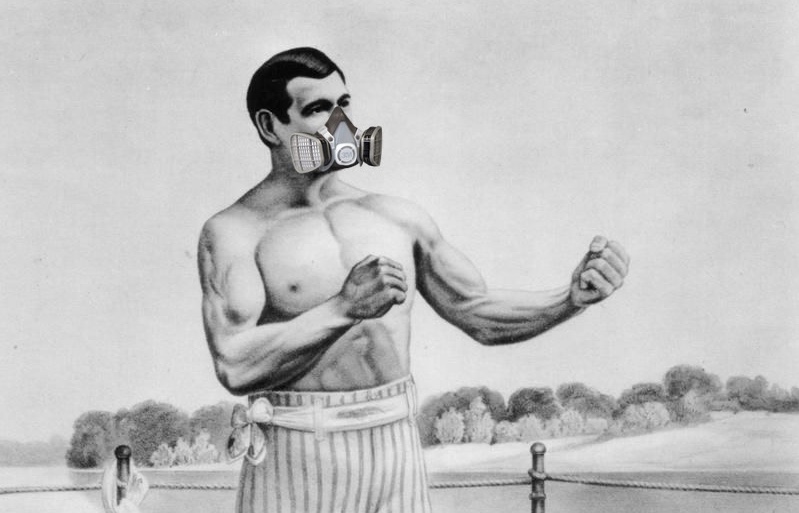
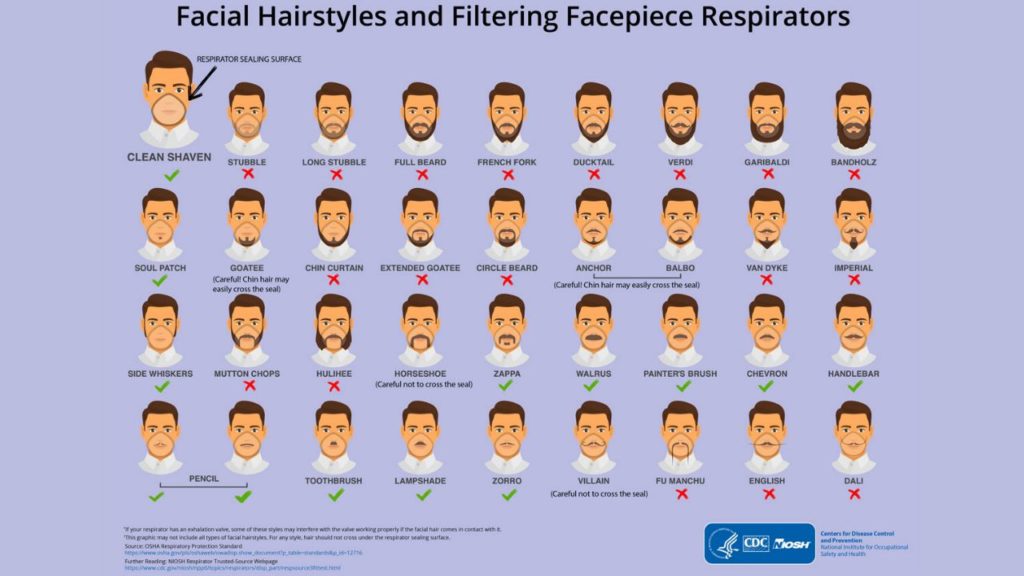
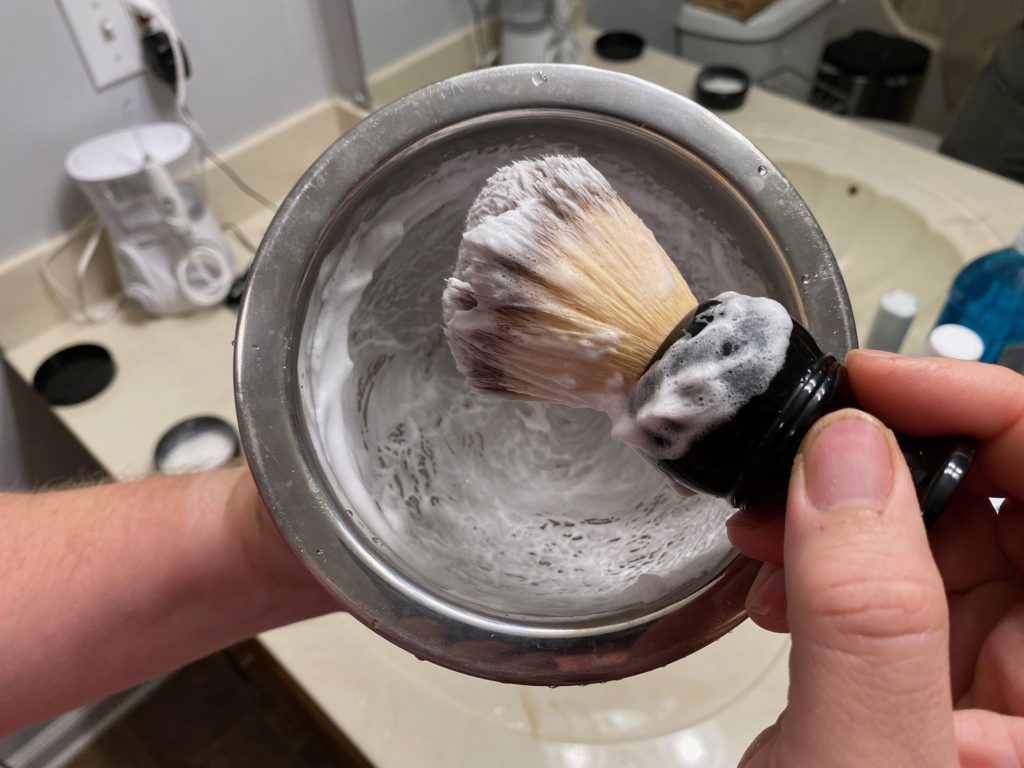
You are reporting the comment """ by on